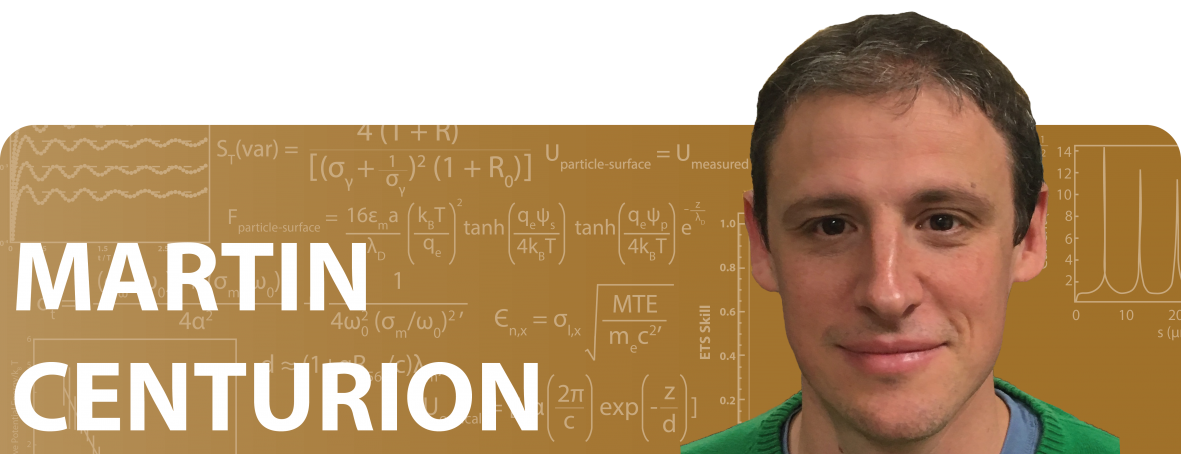WHAT DID THE 2010 EARLY CAREER AWARD ALLOW YOU TO DO?
The conversion of light into other forms of energy is an essential part of the processes of vision, photosynthesis, and DNA damage. The first step in these processes is the absorption of a photon—a quantum of light—by a single molecule. The energy carried by the photon is then converted into heat through vibrations, or into chemical energy by breaking chemical bonds and changing the molecular structure.
These reactions can take place in less than a trillionth of a second.
A detailed understanding of these ultrafast light-driven reactions could enable scientists to develop new ways to transform energy from light and to produce desired chemicals efficiently. But precise details of the dynamics of these reactions are difficult to capture experimentally because they take place on the atomic scale and in extremely short time periods. Therefore, scientists still do not fully understand them.
The Early Career Research Program Award made it possible to develop a new tool to capture images of molecules in real time and with atomic-scale spatial resolution as a reaction is taking place. A short laser pulse triggers a reaction, and a short burst of electrons scatters from the molecule at a very precise time to produce an image of the reaction within a fraction of a trillionth of a second.
This work has produced sequences of snapshots during molecular reactions—essentially capturing a molecular movie—that is helping scientists build predictive models for understanding and controlling energy conversion at the molecular level.
ABOUT:
Martin Centurion is the Susan J. Rosowski Associate Professor in the Department of Physics and Astronomy at the University of Nebraska-Lincoln.
SUPPORTING THE DOE SC MISSION:
The Early Career Research Program provides financial support that is foundational to early career investigators, enabling them to define and direct independent research in areas important to DOE missions. The development of outstanding scientists and research leaders is of paramount importance to the Department of Energy Office of Science. By investing in the next generation of researchers, the Office of Science champions lifelong careers in discovery science.
For more information, please go to the Early Career Research Program.
THE 2010 PROJECT ABSTRACT:
Ultrafast Electron Diffraction from Aligned Molecules
The goal of this project is to capture the three‐dimensional structure and dynamics of molecules with atomic resolution using ultrafast electron diffraction. Electron diffraction from molecules in the gas phase is a successful technique for determining the structure of isolated molecules. Due to the random orientation of molecules in a gas, only one‐dimensional information such as bond lengths can be retrieved from the diffraction patterns.
The experimental method proposed in this work solves this problem by combining electron diffraction with laser alignment. This will allow the retrieval of full three‐dimensional images of molecular structure. A key to the success of this project will be the design and implementation of a new instrument to produce ultrafast pulses of electrons. After demonstrating the ability to record static images of small molecules, the method will be extended to more complex molecules such as biomolecules that cannot be crystallized. The method will also be extended to study the dynamics of molecules in space and time.
RESOURCES:
Yang, J., Zhu, X., Wolf, T.J.A., Li, Z., Nunes, J.P.F., Coffee, R., Cryan, J.P., Gühr, M., Hegazy, K., Heinz, T.F., Jobe, K., Li, R., Shen, X., Veccione, T., Weathersby, S., Wilkin, K.J., Yoneda, C., Zheng, Q., Martinez, T.J., Centurion, M., and Wang, X., “Imaging CF3I conical intersection and photodissociation dynamics with ultrafast electron diffraction.” Science 361 (6397), 64-67 (2018). [DOI: 10.1126/science.aat0049]
Yang, J., Gühr, M., Shen, X., Li, R., Vecchione, T., Coffee, R.N., Corbett, J., Fry, A., Hartmann, N., Hast, C., Hegazy, K., Jobe, K., Makasyuk, I., Robinson, J., Robinson, M.S., Vetter, S., Weathersby, S., Yoneda, C., Wang, X., and Centurion, M., “Diffractive imaging of coherent nuclear motion in isolated molecules.” Physical Review Letters 117, 153002 (2016). [https://journals.aps.org/prl/abstract/10.1103/PhysRevLett.117.153002]
Hensley, C.J., Yang, J., and Centurion, M., “Imaging of isolated molecules with ultrafast electron pulses.” Physical Review Letters 109, 133202 (2012). [https://journals.aps.org/prl/abstract/10.1103/PhysRevLett.109.133202]
Additional profiles of the 2010 Early Career Award winners can be found at https://www.energy.gov/science/listings/early-career-program.
The Office of Science is the single largest supporter of basic research in the physical sciences in the United States and is working to address some of the most pressing challenges of our time. For more information, please visit www.energy.gov/science.
